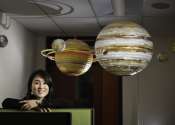Astronomers discover an unusually low-density super-Earth
An international team of astronomers reports the detection of a new "super-Earth" exoplanet using NASA's Transiting Exoplanet Survey Satellite (TESS). The newfound alien world, designated TOI-244 b, turns out to have an unusually ...









